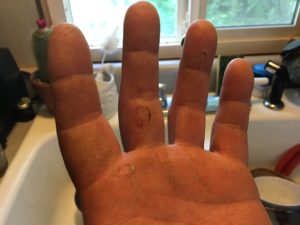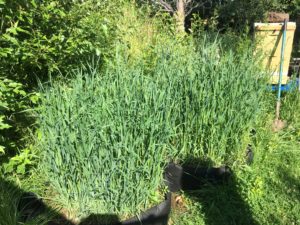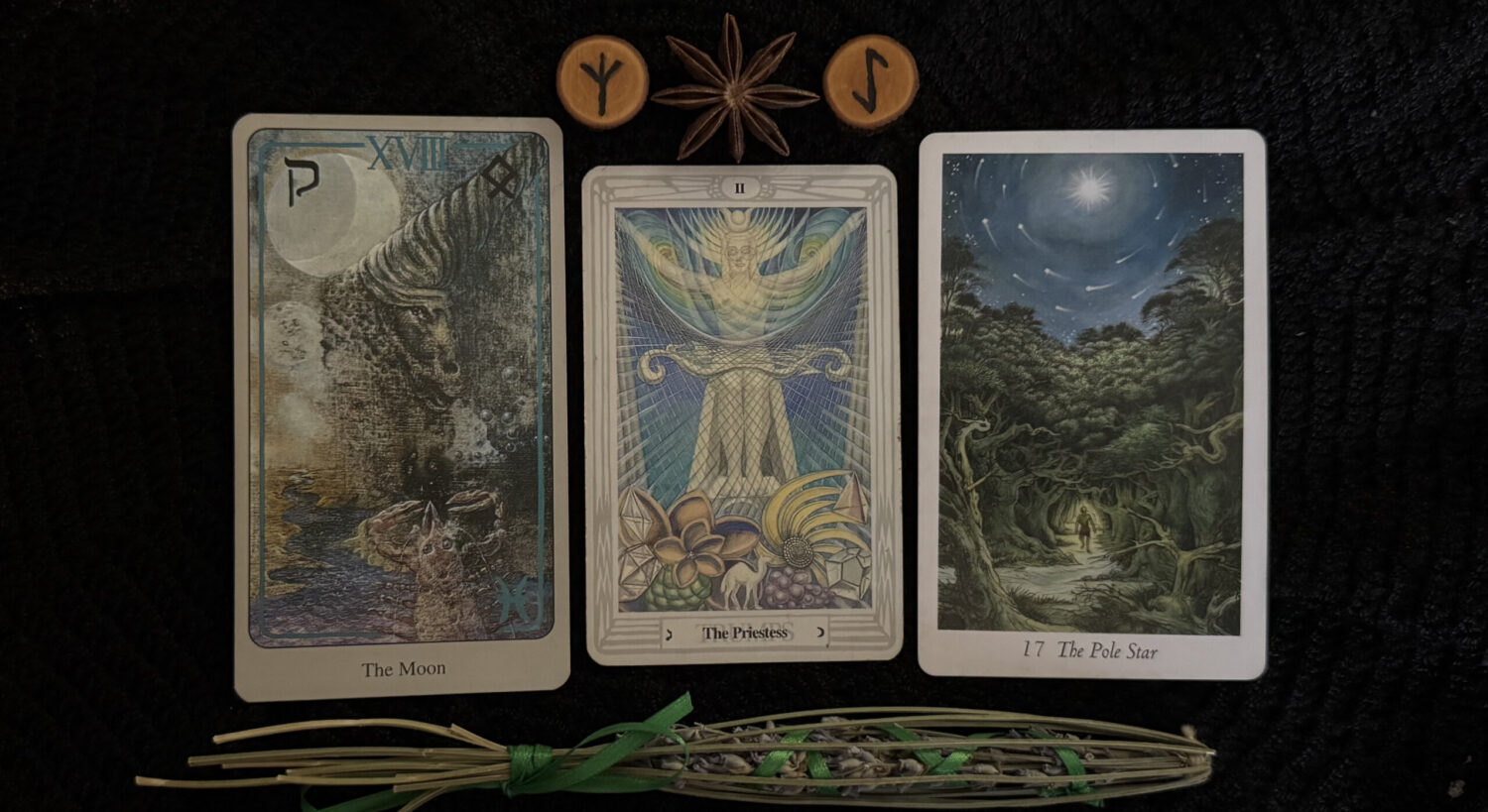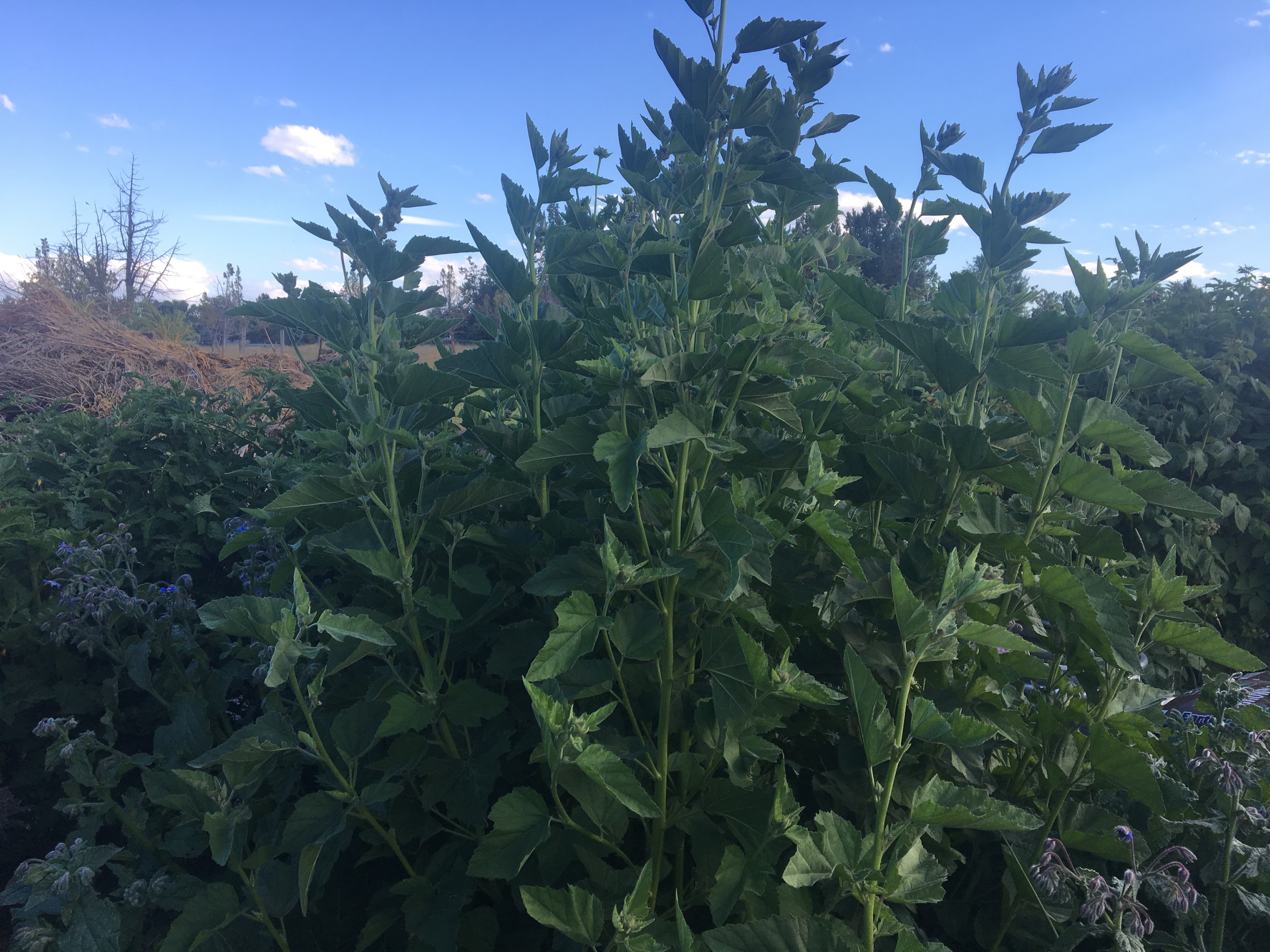Three of my favorite medicinal plants are comfrey, oats (seed and straw), and marshmallow. Each plant is demulcent and soothing to the body, both inside and out. They work on the nervous system by soothing nerve endings and on the respiratory and urinary systems by soothing inflamed membranes. Plus, they’re full of vitamins and minerals. Let’s take a look at each herb.
Comfrey
Also known as knitbone, bruisewort, miracle herb, and healing herb, comfrey, Symphytum officinale Boraginaceae, was growing on my property before we moved here. After reaching around a foot high, bluish flowers rise up attracting my honeybees as well as wild bumblebees and other pollinators.
The leaves and roots are medicinal containing constituents such as allantoin for wound healing, along with alkaloids, tannins, volatile oils, resin, mucilage, and gum, and are considered to have astringent, demulcent, and expectorant properties. Comfrey’s mucilage alone can be used on insect bites, rashes, and wounds. Along with plantain, comfrey is my go-to choice for bee stings and mosquito bites. I typically experience inflammation, swelling, and thickening of the sting area if one of my honeybees happens to sting me when working with the hive. I wouldn’t say that I’m allergic necessarily, but clearly, I experience something.
So, one day, after being stung, I walked over to one of my comfrey plants and took one of the leaves and split the stem with my thumbnail. A small knife works too. I scraped out the gel-like fibrous substance similar in texture to aloe and smeared it all over the bee sting as a poultice. The area of the sting instantly felt cool and the itch and pain began to subside. I grabbed a few more leaves, splitting their stems and adding the slimy goo to the poultice.
Any other time I’ve been stung, it takes around a month for the area around the sting to heal. It expands as well, so the area could stay red, inflamed, and dense for quite a while before it resolves on its own. With comfrey, however, that time is reduced to a few days.
 The other day my husband grabbed the handle of a skillet out on the grill without thinking and badly burned his fingers and the upper part of his palm. I ran to the closest comfrey plant and pulled off some leaves. I put the slimy goo on his hand and covered it with a large comfrey leaf. Then, to keep it in place, I loosely wrapped some plastic wrap around the poultice while he finished cooking. By the time he was done cooking the comfrey leaf was fairly stuck to his hand so I removed the plastic wrap to allow the poultice to breathe. That was Sunday, and as of today, after only one application of the poultice and a few applications of comfrey liniment, the large blisters that formed are gone and his hand is nearly healed.
The other day my husband grabbed the handle of a skillet out on the grill without thinking and badly burned his fingers and the upper part of his palm. I ran to the closest comfrey plant and pulled off some leaves. I put the slimy goo on his hand and covered it with a large comfrey leaf. Then, to keep it in place, I loosely wrapped some plastic wrap around the poultice while he finished cooking. By the time he was done cooking the comfrey leaf was fairly stuck to his hand so I removed the plastic wrap to allow the poultice to breathe. That was Sunday, and as of today, after only one application of the poultice and a few applications of comfrey liniment, the large blisters that formed are gone and his hand is nearly healed.
Comfrey root is used both internally and externally and as with the leaf can be used in a poultice for broken bones. The leaf is useful in teas and tinctures to treat respiratory and digestive complaints, both acute and chronic, and it reportedly regulates blood sugar levels. It combines well with other soothing herbs such as marshmallow and oat seed and oat straw for rich and healing infusions. For a quick comfrey liniment, I’ve brewed a strong tea and then added some rubbing alcohol as a preservative. I keep the main jar in the refrigerator, but the smaller vial has stayed preserved for over a year left out on the counter.
Oat Seed and Oat Straw
I decided to plant my oats (avena sativa) in three fabric raised beds that I have over in the apiary. I had been growing them each year in the top triangle of my pentagram-shaped medicinal herb garden, but I couldn’t keep other plants from invading, so after struggling, I found these fabric raised beds and they’re really working out well. The oats are several feet high and their seed heads are everywhere. I found enough to cut for tincture which I made yesterday. I like using simples, tinctures created from a single herb. It makes any further formulating easy because I can add different herbs in drops instead of having to create a multi-herb tincture and wait for that to soak a couple of weeks. Essentially simples allow the herbalist to tincture on the fly as it were.
 Most of us view oats as comfort food, but we may not realize why. Oats are made of 50% starch and contain saponins, proteins, avenine, fixed oils, glycosides, and vitamin B. They soothe nerve endings, are considered demulcent and nutritive, and they seem to uplift the mood.
Most of us view oats as comfort food, but we may not realize why. Oats are made of 50% starch and contain saponins, proteins, avenine, fixed oils, glycosides, and vitamin B. They soothe nerve endings, are considered demulcent and nutritive, and they seem to uplift the mood.
I include oat seed and straw in nearly every tea blend I create to add a nourishing component to the formula. It soothes the nervous system when under stress and its silicic acid soothes skin disorders when externally applied as a compress or as part of a soothing salve. Avena sativa is perfect to include in a tea blend to treat menopause symptoms as well as depression.
The seed and stalks are gathered green, with the seed gathered as it begins to release a milky substance when squeezed. Not every seed will do this at the same time, so I gather the seed when they start splitting apart on the ends and take on a slightly lighter green color than when they first appear. What you don’t want to do is to wait until they turn a golden color. Then, the oats have progressed too far to be used in tinctures.
Dry the seed and stalks away from the light and give them as much time as possible to fully dry. I chop up my stalks fairly small to assist in drying. But if I don’t wait a few weeks for them to become fully dry, and I jar them up before they’re ready, some interesting smells await me the next time I open the jar. Trust me, the rotting smell can definitely clear a room.
Marshmallow
Related to the hollyhock plant, marshmallows were originally made from a decoction of marshmallow root. I would venture to guess that they didn’t look like the puffy confections that we all know today, but marshmallow’s cooling energy, sweet flavor, and demulcent properties make it useful as for nutritive, alterative, and diuretic support.
As you can see from the above picture, marshmallow (Althea officinalis) grows quite tall with beautiful flowers eventually forming. All portions of the plant are considered medicinal and soothe inflammation both internally and externally. Marshmallow can be used as a poultice on wounds and burns and as part of an infusion, can soothe any number of digestive complaints.
Combined with gravel root and juniper berry, marshmallow may help break down gravel or kidney stones and soothe irritation associated with diarrhea. The herbalist Richo Cech suggests a cold infusion is better than hot saying
When the mucous membranes of the mouth and throat are so swollen that even the drinking of pure water becomes a chore, the cold infusion of marshmallow will slide down with ease. (p 182)
I include marshmallow leaf in menopause-related tea blends as well as a nutritive in tea blends to rebuild tissue and bones.
Teas, Infusions, and Tinctures
For fresh herb tinctures, I use grain alcohol to account for the water content of the fresh plant. Otherwise, I would use 80 proof vodka. But when using grain alcohol, the eventual tincture will need to be diluted before use. Grain alcohol is 195 proof making it nearly 100% alcohol which is poisonous to ingest. Even when using the higher strengths of rubbing alcohol for liniment, it may be best to dilute that as well if the liniment seems too drying. But with grain alcohol, it’s required.
I typically dilute grain alcohol tinctures with distilled water or I make a glycerite by adding glycerin. Well, it’s more than just pouring in glycerin, it’s actually like making a syrup. A cup of glycerine to a cup of alcohol tincture simmered uncovered without boiling until it’s reduced to a cup creates a lovely glycerite. The alcohol is basically reduced to almost nothing and a nice non-alcohol herbal tincture remains.
[wordads]
Infusion is another word for tea, but in the case of the infusions I create, I use more than a tea bag’s worth of herb, so when I use the term infusion, I’m referring to more than a teaspoon’s worth of dried herb to make the tea. In my case, I use two to three healthy pinches of an herb blend in a French Press to make my medicinal infusions which may end up filling around a quarter to a third of the pot with herbs.
Fresh or dried herb can be used in teas and infusions with fresh typically the best option. It’s not uncommon for me to wander about my property, gathering this or that leaf or flower to add for the day’s tea. I prefer fresh if possible, but if not, I usually have plenty gathered from the year before.
Each of the herbs discussed can be blended together for a lovely soothing tea. Equal parts of comfrey and marshmallow leaf work well with a few oat seeds or an equal amount of oat straw thrown in as well and you have a wonderfully healing tea.
A little goddess blessing in a cup!
Until next time…
Herbal Blessings!
References:
- Hoffmann, David. Holistic Herbal: A Safe and Practical Guide to Making and Using Herbal Remedies (Kindle Locations 5615-5616). HarperCollins Publishers. Kindle Edition.
- Tierra, Michael (1998-08-01). The Way of Herbs (pp. 172-173). Pocket Books. Kindle Edition.
- Cech, Richo. Making Plant Medicine (p. 182). Horizon Herbs LLC. Kindle Edition.
If anyone intends to either quote something I've written, or intends to post any part of my work, including my videos, on any other site, please ask permission before doing so. Any reposting of my work without permission can be considered as copyright infringement, so please ask. And if I give permission, you MUST clearly reference my name as author and my website. No exceptions. The words an author writes are sacred. Unapproved use is not.
Thank you... Jan Erickson




